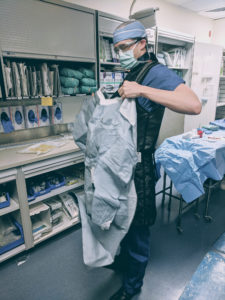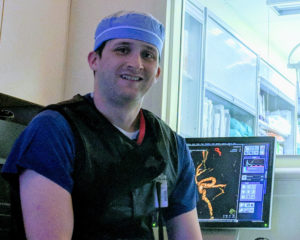Neurosurgery Resident Alumni: Colin Son, MD

What I appreciated about my training at The University of Texas Health Science Center at San Antonio:
“The clinical volume and breadth of practice environments I got to see were great. It has set me up well for my future practice. One of the first cases I ever did out of residency was an intraventricular meningioma in a young guy with a trapped temporal horn. Not exactly an ACDF or a subdural. I got a call from a more senior guy in the department before surgery just asking [about] my plan and making sure I was comfortable with the case. I had gotten it on-call. Talking the case over, I knew I was just ready and prepared and knew the patient was in good hands. All of that goes to my training in residency, obviously. And the guy did well. I’m really grateful for the clinical and technical training I got in San Antonio.
 “I am currently a fellow at the University of Wisconsin in neuroendovascular surgery. It’s a relatively busy clinical program. I will probably end up doing close to a thousand angiograms and interventions over my twelve-month fellowship. I’m in the angiosuite most days with our scheduled cases except for Wednesday, which is a full clinic day. In addition to the scheduled angiograms and aneurysm embolizations and stents, there are plenty of emergency cases, including strokes and ruptured aneurysms. I have a small general neurosurgery practice as faculty where I take some general cranial call and have a small clinic for things like trauma and brain tumors. I work in those cases I get on-call on a case-by-case basis. It’s good to keep fresh in terms of being in the OR and it also helps fund my fellowship. My fellowship comes to an end in June. As it winds down these last few months, I can say I’ve been really pleased with the experience and appreciate everyone in San Antonio who helped me get here.”
“I am currently a fellow at the University of Wisconsin in neuroendovascular surgery. It’s a relatively busy clinical program. I will probably end up doing close to a thousand angiograms and interventions over my twelve-month fellowship. I’m in the angiosuite most days with our scheduled cases except for Wednesday, which is a full clinic day. In addition to the scheduled angiograms and aneurysm embolizations and stents, there are plenty of emergency cases, including strokes and ruptured aneurysms. I have a small general neurosurgery practice as faculty where I take some general cranial call and have a small clinic for things like trauma and brain tumors. I work in those cases I get on-call on a case-by-case basis. It’s good to keep fresh in terms of being in the OR and it also helps fund my fellowship. My fellowship comes to an end in June. As it winds down these last few months, I can say I’ve been really pleased with the experience and appreciate everyone in San Antonio who helped me get here.”
– Colin Son, MD, Resident Graduate 2017
